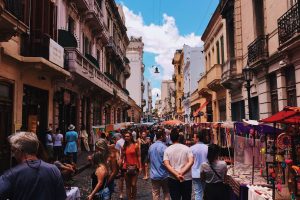Tourism’s Impact: Exploring the Multiplier Effect in Tourism
Tourism has always been a powerful force in driving economies worldwide. One concept that helps explain its substantial impact is the “multiplier effect.” This economic term refers to how a single unit of spending in an economy creates a chain of economic benefits. In tourism, this effect helps us understand how the money tourists spend cascades through local economies, benefiting various sectors and communities.
What is the Multiplier Effect in Tourism?
The multiplier effect in tourism describes the process by which money spent by tourists circulates through a local economy, generating additional economic activity. When a tourist visits a destination, they typically spend money on accommodation, food, transport, attractions, and entertainment. This spending doesn’t just stay in the pocket of the businesses where the money was first spent. Instead, it gets passed on, generating wages for employees, which they then spend in the local community, further stimulating economic activity.
This process continues multiple times, with each round of spending contributing to the overall economic activity in the area. The multiplier effect is crucial for understanding how tourism can create sustained economic growth, far beyond the initial spend of visitors.
The Economic Multiplier Effect in Tourism
The economic multiplier effect in tourism is a key concept for understanding the broader benefits of tourism beyond direct revenue generation. It highlights the significant role that tourism plays in local economies by impacting not only tourism-related businesses but also a range of other sectors.
Understanding the Economic Multiplier in Tourism
In tourism, the multiplier effect is generally categorized into three stages: direct, indirect, and induced effects. These stages describe how tourist spending flows through the economy, benefiting various sectors.
- Direct Effects: The immediate economic benefits generated from tourist spending, such as payments made to hotels, restaurants, and tour operators.
- Indirect Effects: The secondary impact of tourist spending on other industries, such as local suppliers providing goods and services to tourism businesses.
- Induced Effects: The tertiary effects that arise from employees spending their wages in the local economy, from purchasing groceries to attending entertainment events.
By understanding the stages of the economic multiplier effect, tourism stakeholders can gain insight into how their actions influence the broader economic landscape.
How the Economic Multiplier Works
Tourism spending typically follows a cyclical path within an economy. A simple example is when a tourist spends money on a hotel room. The hotel owner then uses a portion of that revenue to pay employees and purchase local goods. The wages of these employees are then spent on groceries, dining out, and other services in the community. This repeated circulation of money is the essence of the multiplier effect in tourism, where each round of spending generates more income and more jobs for the local economy.
The Role of Tourism Spending in the Multiplier Effect
One of the main reasons why the multiplier effect is so significant in tourism is the impact it has on local businesses and job creation.
Tourism’s Impact on Local Businesses
Tourist spending supports a wide array of local businesses, such as restaurants, shops, attractions, and service providers. Every time a tourist buys a meal, books a tour, or shops for souvenirs, it contributes directly to the business they purchase from. This spending helps these businesses maintain operations, expand services, and employ more people.
Job Creation and Employment in the Tourism Sector
The multiplier effect also plays a key role in job creation. Tourism spending doesn’t just create jobs directly within tourism-related sectors; it also creates employment opportunities in other industries. For instance, the hotel sector hires staff, but these workers may spend their earnings at local stores, creating demand for goods and services in non-tourism sectors. This widespread employment generation is a direct result of the multiplier effect, ensuring that tourism benefits are distributed throughout the community.
Multiplier Effect Travel and Tourism: A Global Perspective
While the multiplier effect in tourism is often observed at a local level, its impact can be seen globally, with some countries reaping immense economic benefits from tourism.
Comparison of the Multiplier Effect in Developed vs. Developing Countries
The multiplier effect can differ significantly between developed and developing countries. In developed nations, the tourism sector is often well-integrated with other industries, allowing for a high level of economic circulation. On the other hand, in developing countries, tourism may generate higher multiplier effects because the money spent by tourists can have a significant impact on local communities where other industries are less developed.
The Impact of Tourism on Infrastructure Development
One of the most visible and lasting impacts of tourism spending is on infrastructure development.
How Tourism Spending Leads to Improved Infrastructure
Tourism often leads to investments in infrastructure that benefit not just visitors, but also local residents. Airports, roads, public transport, and communication networks are typically upgraded to accommodate the influx of tourists. These improvements often enhance the quality of life for local residents as well, opening up new economic opportunities.
Long-Term Economic Benefits of Improved Infrastructure
The long-term benefits of tourism-driven infrastructure development can be substantial. For example, better transportation networks make it easier for locals to commute, while improved communication infrastructure can support businesses and create more job opportunities.
Challenges and Considerations with the Multiplier Effect in Tourism
While the multiplier effect offers many economic benefits, it is important to be aware of its potential drawbacks, particularly concerning sustainability.
Sustainability Concerns
Excessive tourism can lead to environmental degradation, overcrowding, and over-reliance on tourism. These negative impacts can reduce the multiplier effect in the long term, as destinations may struggle to balance economic growth with preserving the natural environment.
Balancing Economic Growth with Social and Environmental Impact
Balancing the benefits of the multiplier effect with the social and environmental impacts of tourism is crucial. Sustainable tourism practices, such as responsible travel and eco-friendly initiatives, can help mitigate these issues and ensure that the benefits of tourism continue to flow through local economies without causing lasting damage.
Conclusion: Maximising the Benefits of the Multiplier Effect in Tourism
The multiplier effect in tourism demonstrates the profound impact that tourism spending has on local and national economies. By understanding how the economic multiplier works, tourism stakeholders can better leverage these benefits to promote sustainable growth. As the tourism industry continues to evolve, it is vital that businesses, governments, and communities work together to maximise the positive economic effects of tourism while managing its environmental and social impact.
Tourism is a powerful tool for driving economic growth, and with careful management, its multiplier effect can continue to benefit communities around the world.


